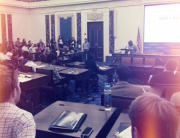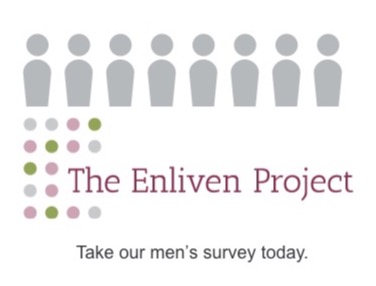With recent attention on UVA and the Rolling Stone story, there has been a new wave of discussion about The Truth About False Accusation graphic on social media and even on the Washington Post that has compelled me write about this topic again, two years later. While I appreciate the prerogative of any journalist, blogger, or regular person to write about anything they believe is relevant to public discourse, I wanted to address directly the idea of “debunking,�? “disproving,�? or “correcting�? the graphic itself.
Understanding the facts is really important – to me, to journalism, and to elevating dialogue on social issues. I created this graphic with my brother, an amazing and talented graphic designer, to visualize data related to sexual violence in a way that would put the fear of false accusation in context with the chances of being prosecuted for sexual assault. It was never designed to prove or disprove anything. It was simply a visual invitation to a deeper conversation on the complexities about sexual assault data.
One night, I posted the graphic on a new personal Tumblr account and by the next morning, it had been shared around the world. Dylan Matthews posted it on the Washington Post’s Wonkblog, Amanda Marcotte wrote a compelling analysis on Slate. As of this morning, the Tumblr post has been shared over 500,000 times, not to mention the many people who shared it on other channels.
I responded to this increased platform and publicity in the most responsible and transparent way that I could. I’ve gone out of my way to make both the intention of the graphic and the sources behind it available for all to see. They are listed on my site, and the original link for the graphic was updated immediately after it went viral so that anyone that clicks on it is directed to a lengthy explanation. Even further, there is a URL on the graphic itself for those who downloaded it and shared it independently of how it was released.
There has been so much meaning attributed to a single image. It’s “proof�? that women don’t lie about sexual violence. It’s “proof�? that feminists distort facts to create rape hysteria. This graphic was NEVER intended to be proof of anything. It didn’t make assertions about the rights of the accused vs. the rights of the accusers. And it certainly wasn’t designed to shut down conversation about sexual violence. It wasn’t meant to be a conclusion or even a fact. It was the start of a longer, nuanced discussion. I am just as dismayed as the next person to see this image being used to support polarizing, extreme, and destructive points of view. That’s not my style, and it’s not the kind of dialogue I want to see in the world.
Some people saw the graphic and chose to learn what was behind it. Others did not. What makes me the most sad is the people who make assumptions about my intentions, and who judge quickly without learning more. At the end of the day, I am a private citizen, a writer, a blogger. The Enliven Project is a personal project, essentially a blog. I write about nonprofit leadership, sexual violence, and parenthood because these are issues that matter to me. The Enliven Project isn’t funded - it’s a passion project I do for free.
Since the Truth About False Accusation was initially circulated, I’ve created additional visualizations and written numerous posts about all aspects of sexual violence and other issues that matter to me. I do this because I think constructive dialogue about challenging issues is critical to our health as humans and as a society. These conversations don’t happen in soundbytes, hashtags, or single images.
Journalists, nonprofit leaders, college students and private citizens like me should be telling stories like these and like these, until it doesn’t require an act of bravery to tell them anymore. I’m game for real conversation. Are you?
(And no, I will not be releasing another version of the Truth About False Accusation. I stand by the graphic and its intentions, and simply ask you to use it responsibly.)






Sarah, You have a beautiful blog and it is unfortunate that the Washington Post and others cannot accept the truth behind what you are trying to do and say. I have been upset by the “debunking” and “discrediting” going on especially by the Post. They have had some good articles. I’m not saying that. But they consistently use a turn or phrase or a mode of presentation to distort what I see as truth. I wonder why they attacked “Jackie” with such vitriol. I don’t understand. And they cheer that they have reached “end game”. Jackie’s rape wasn’t a football game and it my belief it happened. I have recently blogged about it and I hope you will consider reading it. Thanks. http://hannahpowers.net/2015/02/03/anatomy-of-uva-rape-cover-up-or-the-washington-post-vs-jackie/
Sarah, I admire you for your attempt - but your graphic is being used as evidence in blogs - and I’ve just taken a thrashing just for trying to discuss it openly.
The “falsely accused” are in the wrong place - those rapes are reported but moreover, the image contains men (I know these are supposed to be neuter graphics, but they’re obviously not).
In fact - many, many bloggers (on both sides) are using this to deepen the rift between the two genders using it as a statistic. That is very, very sad; in applied science we call this the “law of unexpected consequences” and in this case, your good intentions are causing a huge amount of damage.
It’s a bad graphic with the right intention.
This chart tells an amazing story about rape culture – that really is FALSE ACCUSATION CULTURE in reality. Feminists have been trying hard to convince us that false rape accusations are only about 2% based on the imagination of feminists and man hating author Susan Brownmiller. The graphic was created by Sarah Beaulieu of the Eliven Project another false accusation apologist. The graph is meant to show that false accusations are so miniscule that it needs to be ignored. Her graphic shows 2/1000 rapists are falsely accused. This is wrong on so many levels – is she speaking about rapists or rapes? We know that most of the rapes are committed by very few men in society, although sexual violence is fairly evenly distributed throughout the sexes (CDC 2014). Her message is “ignore the false accusers�? – they don’t exist, my right to accuse an innocent person supersedes your right to justice. Even when pointed out by several media houses of the faulty chart she was virally distributing – her response was “And no, I will not be releasing another version of the Truth About False Accusation. I stand by the graphic and its intentions, and simply ask you to use it responsibly.�?
This supports an amazing fact that women are prepared to lie for their privilege. And its not just women lie about rape accusations but the wider community of women are prepared to lie with them. How gloomy is that. How long can our society last if we have such a significant group that is prepared to lie and be dishonest for their personal gain and exploit others (men that support feminism) in order to execute oppression on another group?
In 2014 when Rolling Stone feminist author, Sabrina Rubin Erdely hand picked a rape story to suit the feminist Rape Culture narrative at the time, one cannot help but draw the conclusion that Rape culture is a deliberate feminist fabrication to promote female privilege, when the story appear to be totally without merit. Again the response from feminists in the wider community was that we should ignore the falsehood and instead focus on the message that Rape Culture is a thing. No, Zerlina Maxwell – False Accusation amongst feminist women are a thing. And we should not believe every woman’s story automatically. That’s incredibly tyrannical to adopt such a policy. If we don’t understand Female culture and its incompatibility with truth and justice – Nothing would. Its time we admit that Feminism is hate culture meant to oppress anyone that gets in the way.
While I can agree with much of your comment Mr Ganness I think you may have illuminated a bit more than you meant to.
What your comment shows is that there are people willing to extrapolate the dishonest behavior of a tiny number of neo-feminists and their media shills to “the wider community of women” in general.
What both the OP and your response say to me is that there is a small number of people who are thoroughly entrenched in their own sick gender war ideology and eager to spread their disease to the rest of us.
I agree with Ginevra. Very well said!
Well said.